Shoe Terminology
With up to 30 individual components used to make up just one shoe, there is no wonder there is also an extensive list of terms used to describe each part of the shoe. Below is an alphabetical list that will hopefully help to explain some of the more commonly used terms when talking about footwear.
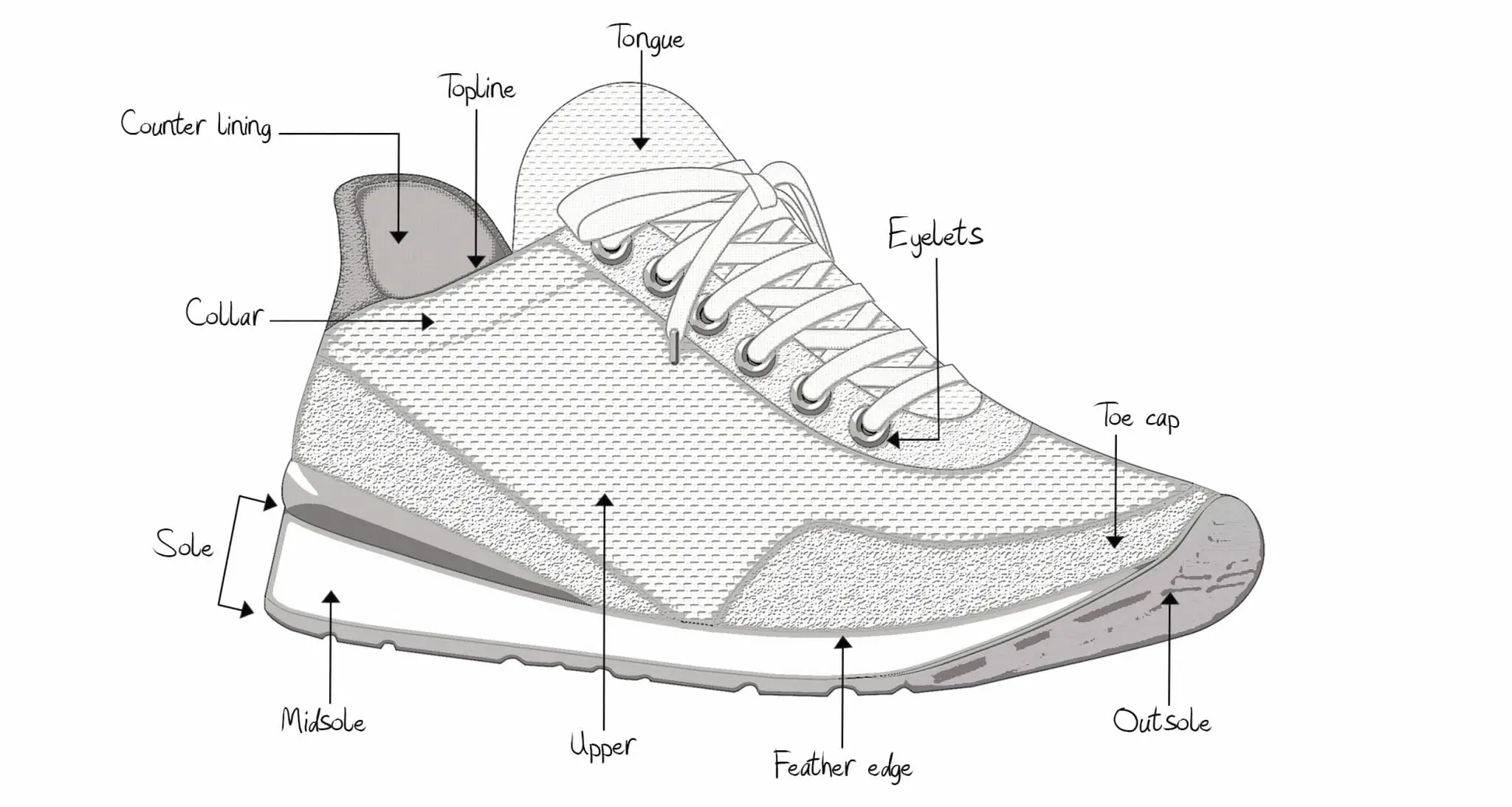
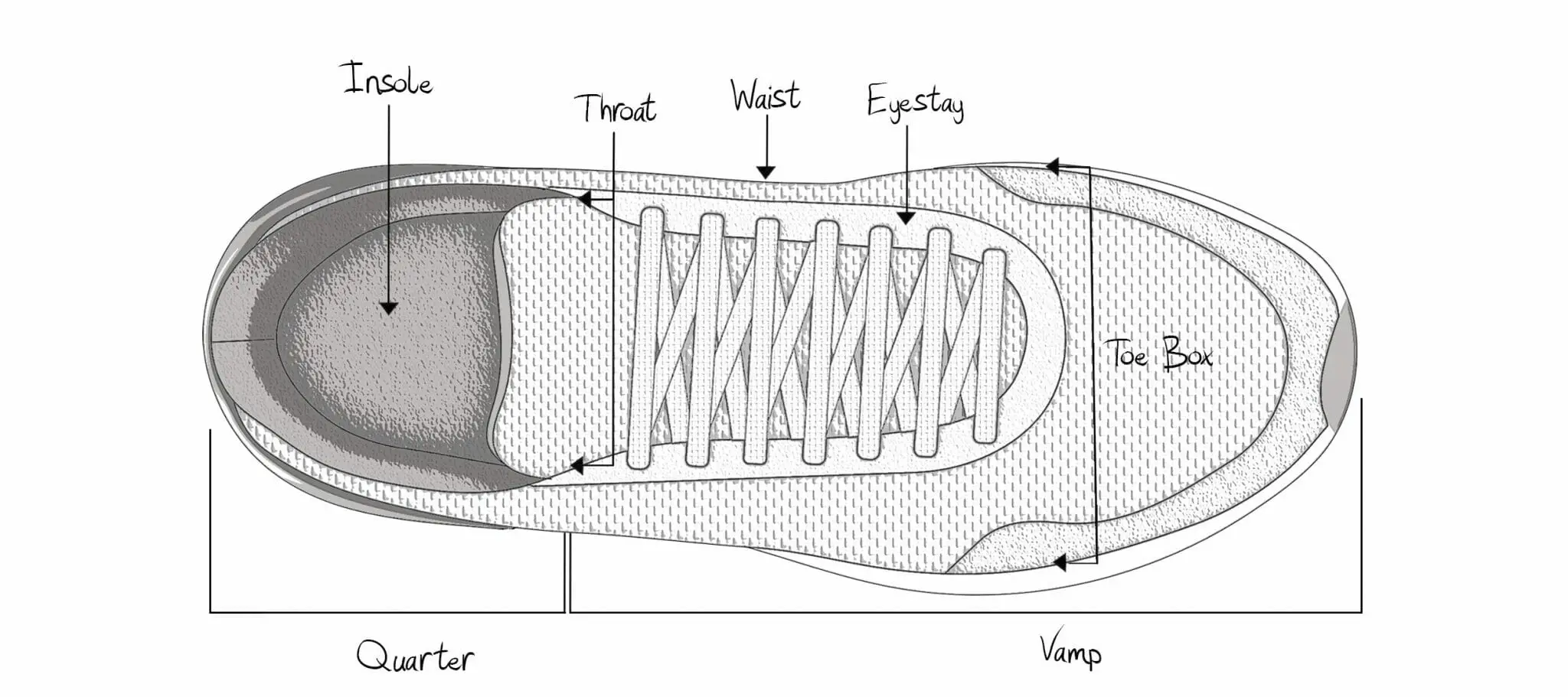
External Parts of the Shoe
The following is a list of terms used to describe the outer parts of the shoe. Some terms refer to components that all shoes have, such as the sole. While other terms may only apply to certain types or style of shoe.
Backstay: The area of a heel counter that runs vertically down its center.
Breast: The forward facing part of the heel, under the arch of the sole.
Counter: A piece of material forming the back of a shoe to give support and stiffen the material around the heel and help maintain the shape of the shoe. The counter helps strengthen the rear of the shoe.
Collar: The top edge of the quarter, where you insert your foot. This is often padded for extra comfort.
Eyestay: Also known as the lace stay, this is the section of a shoe where the eyelets are placed and the laces threaded through.
Eyelet: The holes through which laces are passed, these are often reinforced with metal or plastic. Lace-up shoes can have as little as one eyelet, lace-up boots can have nine or more.
Feather edge: The part of the shoe where the upper’s edge meets the sole, sometimes called just the feather.
Heel: The heel is the part of the sole that raises the rear of the shoe in relation to the front. See also heal seat and top piece.
Heel seat: This is the top of the heel that touches the upper, this is typically shaped to match the form of the upper.
Quarter: The rear and sides of the upper that covers the heel which are behind the vamp. The heel section of the quarter is often strengthened with a stiffener, which helps support the rear of the foot. Some shoe designs use a continuous piece of leather for the vamp and quarter
Sole: This is the entire part of the shoe that sits below the wearer’s foot. As opposed to the upper. The upper and sole make up the whole of the shoe.
The sole is usually constructed of several layers:
- Outsole: The exposed part of the sole that is contact with the ground. As with all parts of the shoe, outsoles are made from a variety of materials. The properties the outsole need are: grip, durability, and water resistance
- Midsole: A mid-sole can be found on some shoes but is not always a requirement. The midsole is a layer between the in-sole and the outsole. Often seen in athletic styles to help offer extra suspension.
- Insole: This is inside the shoe, see below for the interior shoe part definitions.
Throat: The front of the vamp next to the toe cap. For shoes where the vamp and quarter panels are one piece the throat is at the eye-stay.
Toe cap: Shoes may have a toe cap in the front upper of the shoe. Toe caps can take various forms and can be both decorative and protective. Toe caps help add strength to the upper front of the shoe, an area that receives a lot of stress and wear from use.
Toe box: The area of a shoe in which the toes reside. Is not actually a box.
Tongue: The part of the shoe that makes contact with the top of your foot. On a lace-up shoe, it resides underneath the eyestay and laces.
Top Piece: The part of the heel that comes in contact with the ground, more commonly seen in high heels and men’s formal styles. Made of a durable material that helps maintain friction with the ground.
Topline: The top edge of the upper.
Upper: The entire part of the shoe that covers the foot.
Vamp: The section of upper that covers the front of the foot as far as the back as the join to the quarter.
Waist: The arch and in-step of the foot
Welt: A strip of material that sits between the upper to the sole to ensure a secure bond.
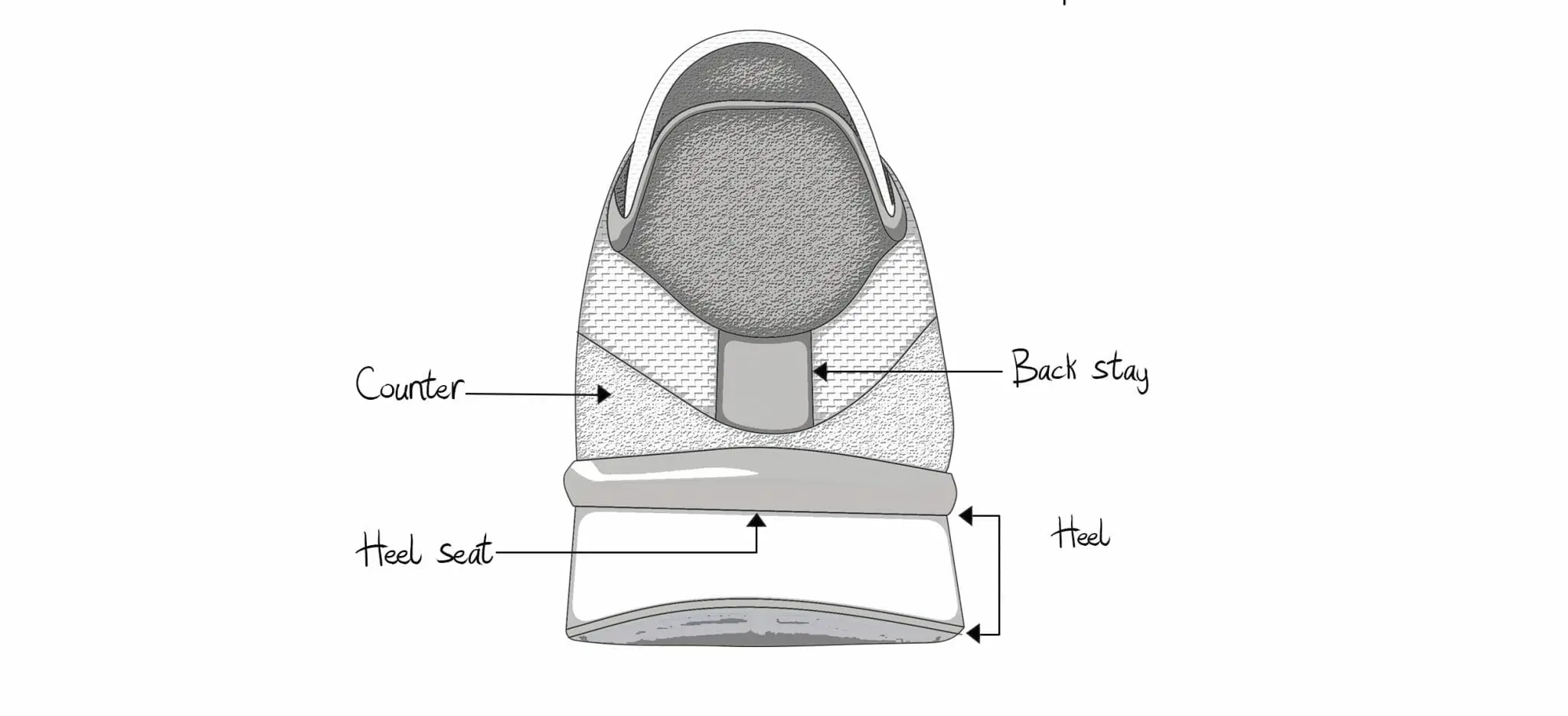
Internal Parts of the Shoe
There are also many terms used to describe the components that help to make up or support the structure of the shoe internally. Not all shoes will have all or any of these components, but it is interesting and useful to know which components can be used to help create a shoe.
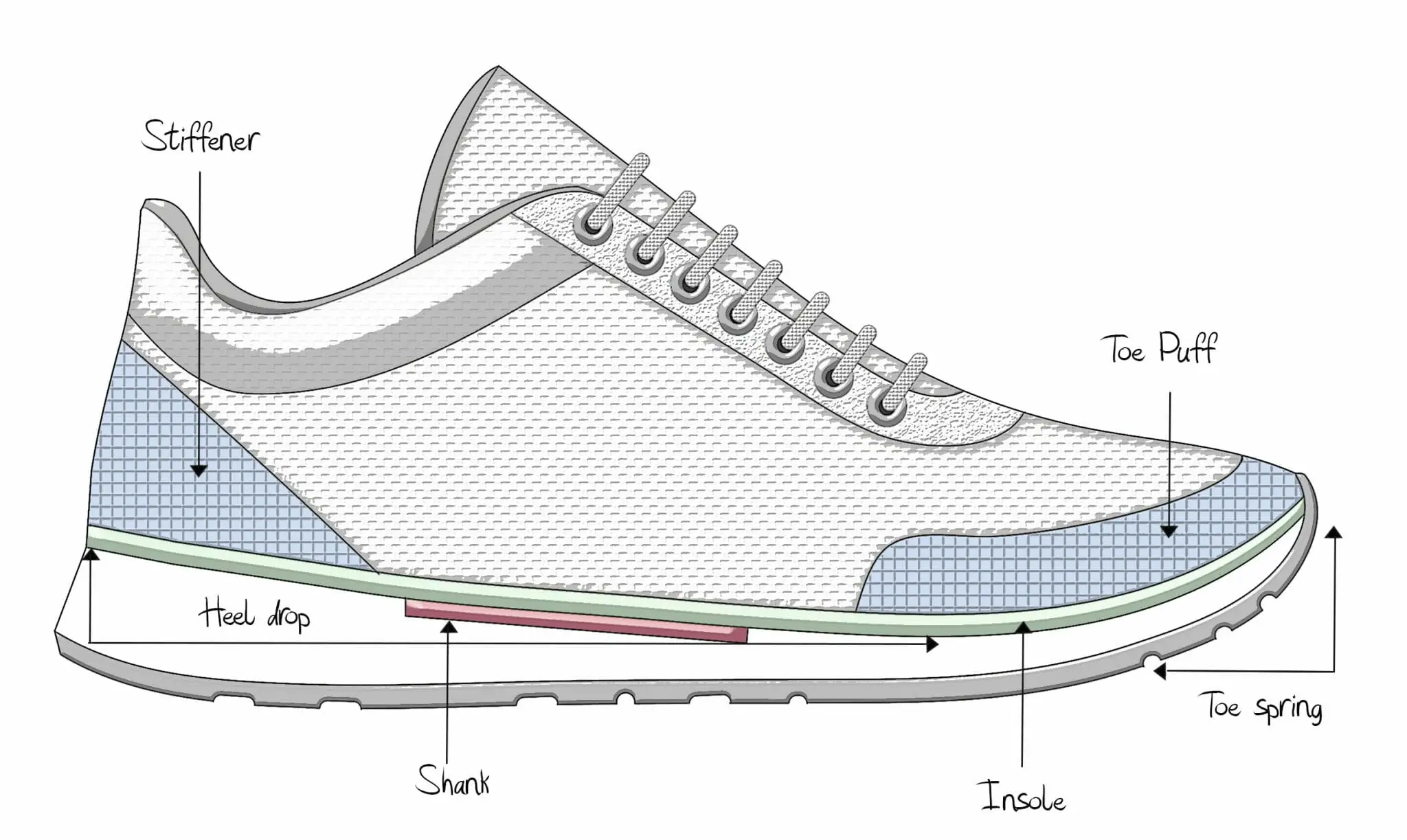
Collar padding: The soft filling used between the lining and upper of the shoe to add comfort around the ankle during wear.
Filler: Elastic material such as cork or felt is used to fill the hollow between the insole and the midsole during construction. More commonly used on dress shoes of a more traditional construction.
Insole: A layer of material that sits inside the shoe that creates a comfortable layer between the sole and the wearer’s foot.
Lining: Most shoes include a lining on the inside of the shoe. These linings improve comfort, breathability and can help increase the lifespan of the shoe.
Counter lining: The material used to line and protect the back part of the shoe – also known as the Counter. This may be a different material to the material used to line the vamp
Tongue lining: The material used to line the tongue section of a shoe. This may be the same material as the vamp lining.
Vamp Lining: The material used to line and protect the front part of the shoe – also known as the vamp. This may be a different material to the material used to line the counter.
Puff: A lightweight reinforcement used inside shoe, placed between the upper and lining materials, which gives the toe its shape and support. Similar in function to a toe cap.
Seat: Where the heel of the foot sits in the shoe. It normally matches the shape of the heel for comfort and support.
Shank: A piece of rigid material placed between the insole and outsole of the shoe. This can be made of metal, wood or plastic. This helps to support the arch of the foot during wear. (If you hear clicking when you walk, it often means that the shank has broken, or come loose inside the shoe and is causing the clicking noise as it move around while you walk.)
Stiffener: This is often placed between the upper and lining materials of the counter, this is a lightweight, sturdy material that can be used to help maintain the shape of the counter, whilst offering support to the heel of the foot.
Tongue padding: The soft filling used between the lining and upper of the tongue to provide comfort to the top of the foot during wear.
Other Useful Terminology
Below is a further list of terms that can be used to describe different features within a shoe, these could be performance based or decorative attributes. Having the below descriptions may help you when looking for the perfect shoe.
Gusseted tongue: A gusseted tongue is often used in boots and sometimes trail shoes. It is a type of tongue in boots that prevents dirt, water, pebbles, and sand from entering your boots through the lace eyelets or the space between the tongue and the upper part of the boot. In this style the tongue is completely attached to the upper preventing material from getting into the boot or shoe.
Heel to toe drop: Also known as HTT drop, offset or just drop. This is the difference in height between the heel and forefoot.
Kiltie: This is a fringe of leather, often with a tassel attached, which is situated on the top of a loafer. They are used in golf shoes, to protect them from mud and grass.
Medallion: The perforations which form a decorative pattern on the toe of a shoe.
Perforations: The holes punched into the upper, these can act as a form of decoration or can aid breathability in the design.
Pinking: These are the cuts in a V-shape, often seen on brogues.
Penny keeper: The name given to the thin strap of leather on a penny loafer.
Stack height: This is the distance measured between your foot and the floor when you have the shoes on.
Toe spring: Toe spring is the rise or curve upward of the sole at the forefoot, this helps to enable the rolling off the forefoot.
Tassel: A decorative fringed piece of leather hanging from the vamp.
Don’t forget that if you want your shoes to feel comfortable, and stay clean, it’s important to choose the best socks. Try bamboo socks for a great feel, you can check out lots more bamboo products at our friends BestBambooGuide.com.
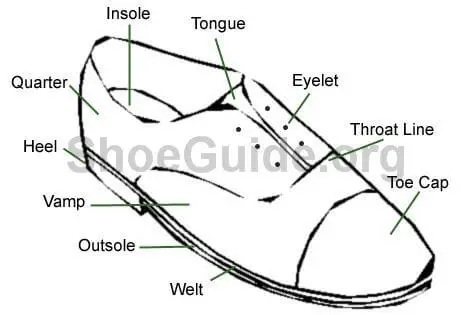

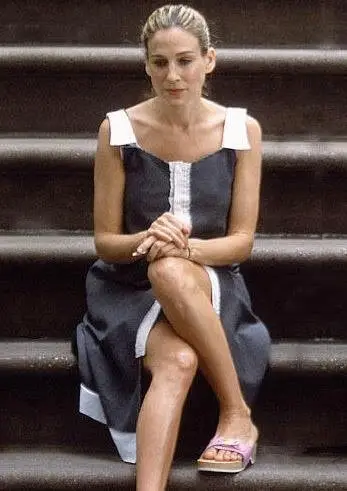

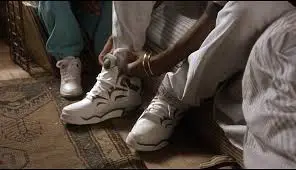

Having difficulty in obtaining a shoe wide enough to fit around a wide foot. Any ideas?
Hi, thanks for leaving a comment!
It depends on what type of shoe you are looking for, but something like the Skechers Sure Track is a good option for a basic non-slip work shoe.
The thing to look out for is the letter or letters after the size. It varies by manufacturer but, in general, N = narrow, M = medium, W or D = wide, XW or 2E = extra wide and 4E = extra extra wide. In general Wide are quite easy to find, and 2E are pretty common as well. If you need the 4E then you’re going to have to hunt around a bit, I’m afraid. I don’t have a go to source for that.
Let me know if that helps!
Thanks, a very useful guide but… What is the name of the piece that joins the side of the tongue to the upper (next to the lace) to stop water getting into the shoe through the part of the shoe above the throat line and between the rows of lace holes?
Hi, thanks for the question!
That style is called a gusseted tongue. We went ahead and added that into the “other terminology” section. I’m not sure there is a name specifically for the material that is used to join the tongue to the upper. It’s pretty common in hiking boots for keeping water, pebbles, etc out of your shoe.
Hope this helps!